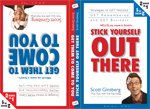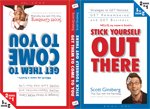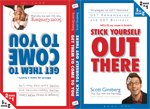 You’ve chosen an uncertain path.
You’ve chosen an uncertain path.
You’ve adopted an inconvenient lifestyle.
You’ve embarked upon an unconventional journey.
You’ve felt the voice inside you growing more urgent.
You’ve committed yourself enough so you can’t turn back.
IN SHORT: You’ve decided to play for keeps.
This is the critical crossroads – the emotional turning point – in the life of every young artist.
I’ve been there myself, and here’s a list of suggestions to help you along the way:(Read part one here, part two here, part three here, part four here and part five here.
Here we go:
1. Act decisively on your creative talents. If you’re not doing the work for yourself, get out now. Courting approval puts a dangerous amount of power in the hands of the audience. And exposing your work too soon and to the wrong eyes will hurt its chances of growing into what it needs to be. Plus, it sets you up for debilitating disappointment.
Look: Art isn’t a game of kickball. You don’t have to wait to get picked to play. Pick yourself. Stop waiting for a publisher. Stop letting the market call the tune. Stop standing by for rejection. Stop insisting that someone who doesn’t matter validate your work. And stop wondering what people will think of you once they see your work.
If the world’s not ready for your feelings, tough shit.
Stay governed by the law of your own being instead of waiting for the masses to tell you your work is okay. Just do it yourself. The fruits of your bravery will not go unnoticed. Are you pushing rocks up hills or rolling snowballs down hills?
2. Continuity builds credibility. Anyone can publish something good. But only a real artist can do it every day. That’s what separates people who make money from people who make history: They’re not writing a book – they’re contributing to an ongoing body of work. They’re not painting a picture – they’re aggregating a lifelong portfolio. And they’re not cutting a record – they’re leaving behind an artistic legacy that, when people write the history books, it will be impossible to leave out.
The hard part is slogging through what matters. Going to work everyday, knowing that you might not get it every day.
I like the way creative writing professor Junot Diaz puts it: “In my view a writer is a writer because even when there is no hope, even when nothing you do shows any sign of promise, you keep writing anyway.”
Remember: Don’t give up the moment before the miracle shows up. Consistency is far better than rare moments of greatness. What’s your daily gift to the world?
3. Market your motivations. In a recent blog post, Seth Godin wrote, “Art is what we call the thing an artist does. It’s not the medium or the oil or the price or whether it hangs on a wall. What matters, what makes it art, is that the person who made it overcame the resistance, ignored the voice of doubt and made something worth making. Something risky. Something human. Art is not in the eye of the beholder – it’s in the soul of the artist.”
Your customers – that is, your viewers, readers, patrons, fans and listeners – are buying more than just your product. They’re also buying your philosophy, your process; along with the meaning people create for themselves in response to your story. It all depends on what statement about humanity your work makes. Are you an icon people can bow down to, or an idea people can latch onto?
4. Make your life larger than your art. Art is subordinate to life – not the other way around. If you have no interests outside of your work, the world will yawn when they see it. My suggestion: Get the hell out of the studio. It’s essential for supporting, enriching, inspiring and informing your work.
What’s more, physical displacement alters your routines and patterns, stimulates creativity and feeds your social spirit – even if it’s just for five minutes.
Without making this conscious effort, however, you won’t be ale to bring anything to the table besides shoptalk. And nothing annoys people more than a one-dimensional artist who maintains such a limited worldview and openness for activities and experiences outside of their scope of interest, that it mars their credibility. Do you invest as much time in your life as in your art?
5. Allow everything you encounter to shape you. As an artist, I have a profound hunger for meaning. I’ve developed an acute sensitivity to my immediate environment. And I prepare myself not to walk away empty handed, wherever I go. What can I say? It’s in the job description. And I think anyone who pursues an artistic endeavor needs to do the same.
Otherwise their creative bank account overdrafts.
I’m reminded of the recent remake of Sherlock Holmes. In the opening scene of the movie, Robert Downey, Jr. grabs the arm of attacker, stopping the invisible dagger millimeters before slicing Watson’s jugular.
“How did you see that?” Watson gasps.
“Because I was looking for it,” Holmes replies.
What are you looking for? What are you listening to? After all, that which goes unsought goes undetected. The cool part is: When you approach life in this way – as a sponge, as a mental omnivore – your experience become living laboratory that never goes obsolete. And if you’re smart enough to vibrate with that bliss, the world will refuse to pass you by. What shapes you?
6. Be a total control freak. In the book Catching the Big Fish, David Lynch explains that it’s a joke to think that a movie is going to mean anything if somebody else fiddles with it. “The filmmaker should decide on every single element. Otherwise it won’t hold together. Even if the film sucks, at least you made it suck on your own.”
That’s the challenge every artist faces: Securing sovereignty over your work. Attaining the freedom to create what you want to create.
And what’s sad is that too many of us surrender this sovereignty. We’re afraid to let our voice ring out. So we allow people to edit us. And then we wonder why we’re grossly disappointed with the final product.
“If you do what you believe in and have a failure, that’s one thing. You can still live with yourself,” Lynch said. “But if you don’t have the final cut – and then the movie fails – it’s like dying twice. And it’s very, very painful.”
Listen to the man: Don’t give away your power supply. Have obsessive faith in yourself. Control everything. Because when you believe in yourself this much, you begin to calculate the odds differently. And that’s how you execute the work that matters. Whom are you allowing to edit your work?
REMEMBER: When you’re ready to play for keeps, your work will never be the same.
Make the decision today.
Show the world that your art isn’t just another expensive hobby.
LET ME ASK YA THIS…
Have you committed with both feet yet?
LET ME SUGGEST THIS…
For the list called, “14 Things You Don’t Have to Do Anymore,” send an email to me, and you win the list for free!
* * * *
Scott Ginsberg
That Guy with the Nametag
Author, Speaker, Entrepreneur, Mentor
[email protected]
Now booking for 2011-2012!
Watch The Nametag Guy in action here!


 Congratulations to Watson, the artificial intelligence program who recently wiped the Jeopardy floor with reining champions, Ken Jennings and Brad Rutter.
Congratulations to Watson, the artificial intelligence program who recently wiped the Jeopardy floor with reining champions, Ken Jennings and Brad Rutter. The world’s FIRST two-in-one, flip-flop book!
The world’s FIRST two-in-one, flip-flop book! You’ve chosen an uncertain path.
You’ve chosen an uncertain path. You’ve chosen an uncertain path.
You’ve chosen an uncertain path. You’ve chosen an uncertain path.
You’ve chosen an uncertain path. The world’s FIRST two-in-one, flip-flop book!
The world’s FIRST two-in-one, flip-flop book! You don’t need permission to dream.
You don’t need permission to dream. “I usually refuse to pay for mentoring. But after Scott’s first brain rental session, the fact that I had paid something to be working with him left my mind – as far as I was concerned, the value of that (and subsequent) exchange of wisdom and knowledge, far outweighed any payment.”
“I usually refuse to pay for mentoring. But after Scott’s first brain rental session, the fact that I had paid something to be working with him left my mind – as far as I was concerned, the value of that (and subsequent) exchange of wisdom and knowledge, far outweighed any payment.” You’ve chosen an uncertain path.
You’ve chosen an uncertain path. The world’s FIRST two-in-one, flip-flop book!
The world’s FIRST two-in-one, flip-flop book! You’ve chosen an uncertain path.
You’ve chosen an uncertain path. The world’s FIRST two-in-one, flip-flop book!
The world’s FIRST two-in-one, flip-flop book!